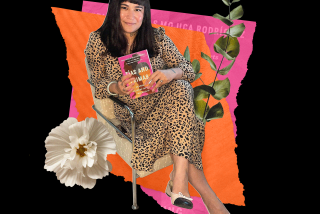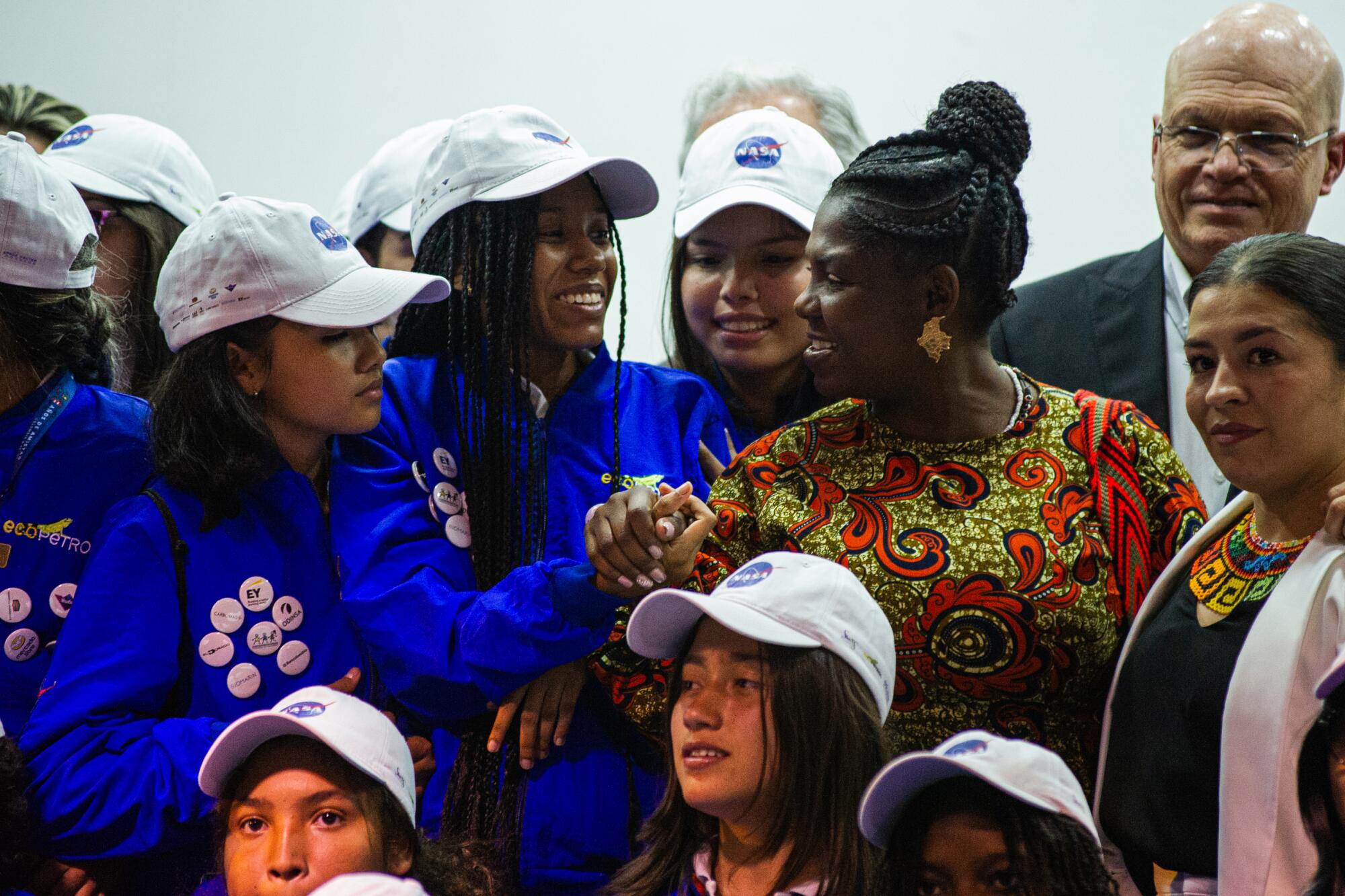
- Share via
LA TOMA, Colombia — Shovel and wooden pan in hand, rubber boots hoisted up to his shins, Leider Ocoró Ambuila strolled past the zapote tree, past the stands of ripening bananas, past the cow pen, down to the banks of the Ovejas river.
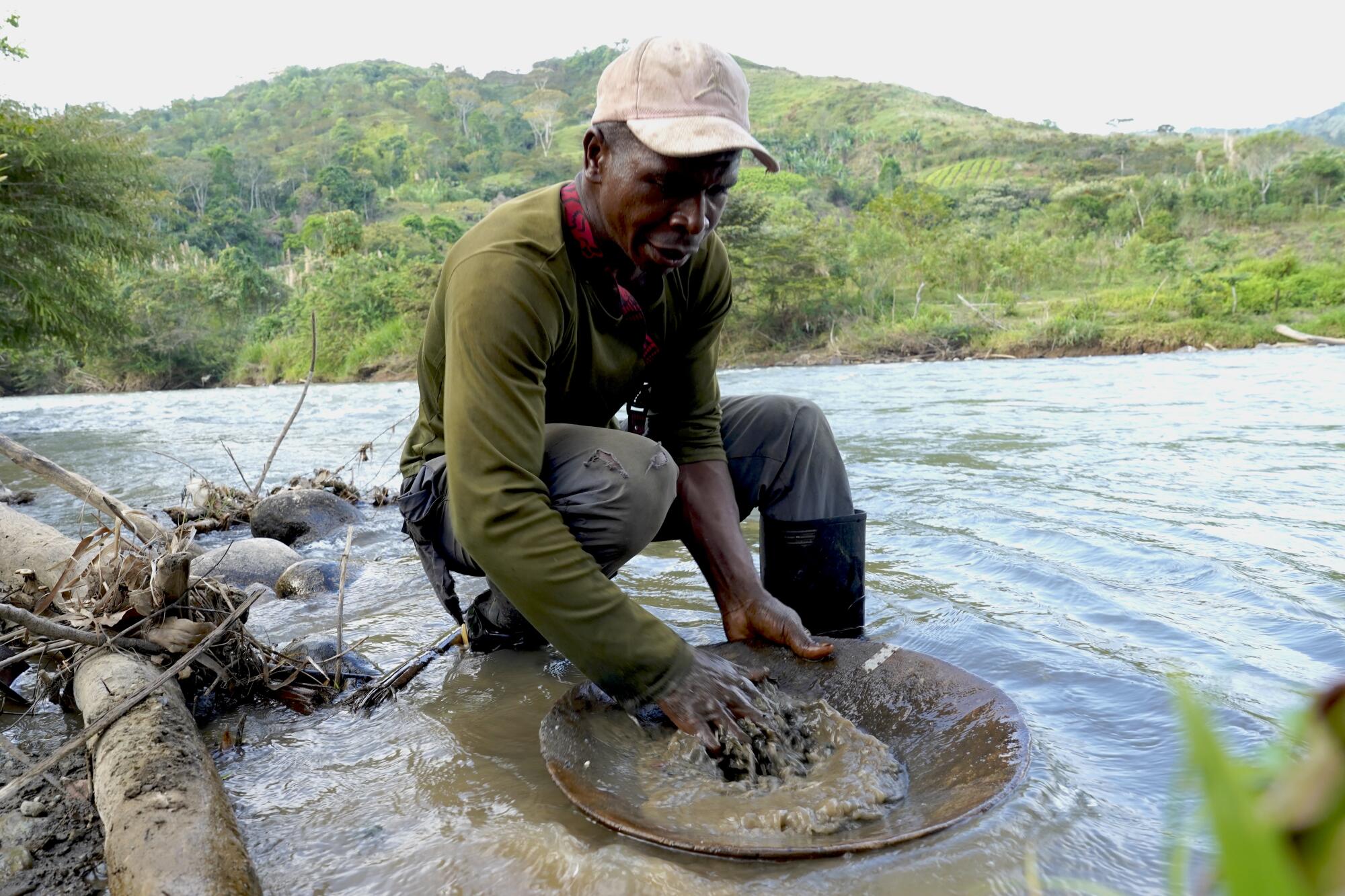
He was soon crouched at waterway’s edge shoveling silt into a concave pan, or batea, a ritual passed down for generations. He splashed water on the grit and tilted the pan to help separate mud and pebbles from the real stuff — gold, minuscule flecks of which soon sparkled from the muck.
“Francia also worked hard to find gold,” said Ocoró Ambuila, 41. “I grew up with her. We played together. She is one of us.”
In these remote parts, where destiny is shaped by water and gold, the reference was clear: Francia Elena Márquez, the most eminent, and provocative, citizen of La Toma, a string of villages and farmsteads spread over verdant hills and valleys that is home to some 8,000 people, overwhelmingly of African ancestry. Most are descendants of slaves brought to South America centuries ago by the Spanish to work in mines and on plantations.
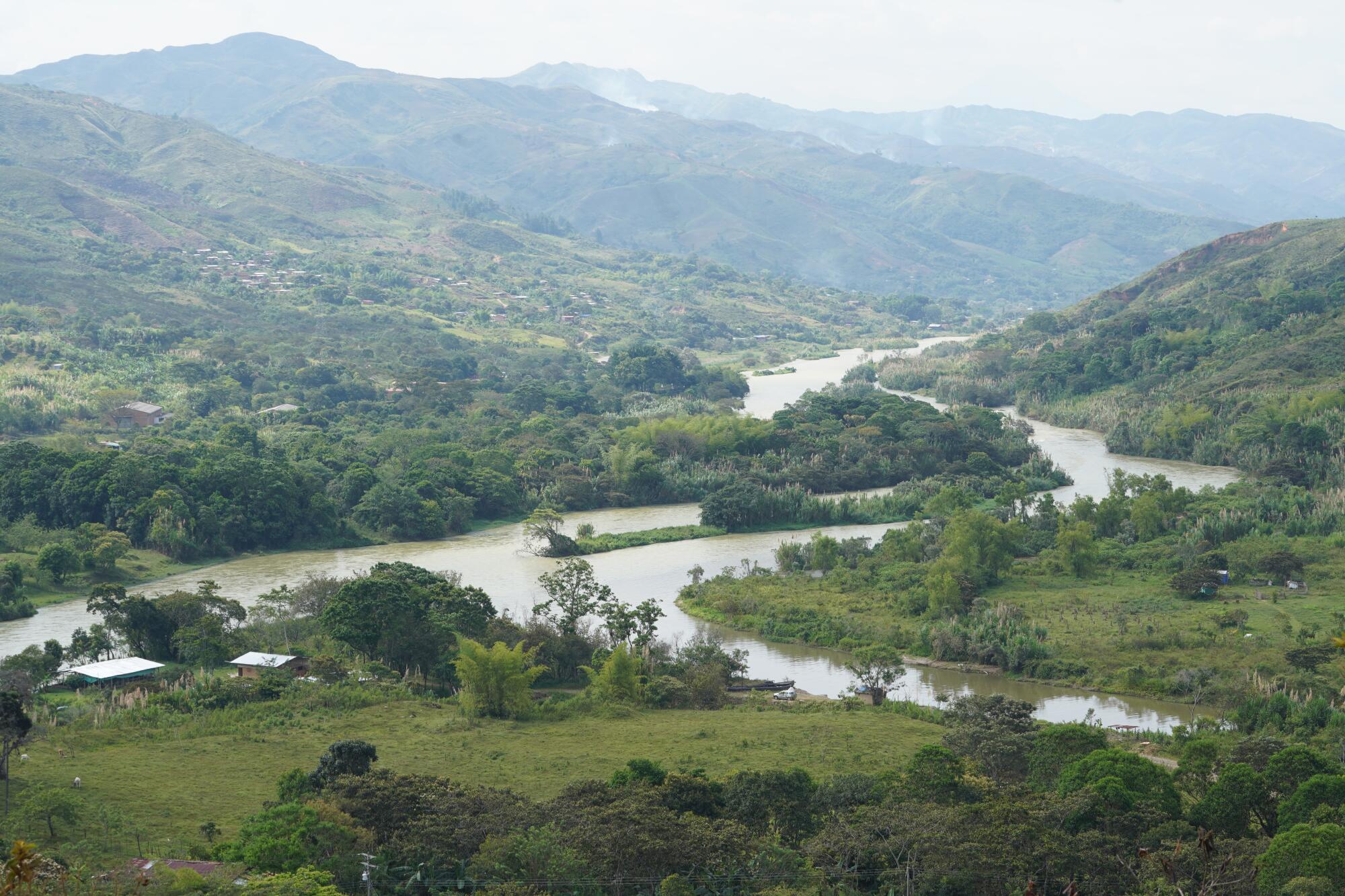
Márquez is a single mother and former live-in maid who escaped rural poverty and threats to become an outspoken social activist — winner of the Goldman Prize, the so-called environmental Nobel, awarded for her battle against large-scale illegal gold mining.
Today, Márquez, 40, sits improbably as Colombia’s vice president. She took office last month alongside President Gustavo Petro, 62, an ex-urban guerrilla and the first leftist chief executive of this nation of 50 million, long a key U.S. strategic ally.
The meteoric rise and ballot-box draw of Márquez — her charismatic appeal with minority, female and young voters helped boost Petro over the top in his third presidential bid — is a singular development, even at a moment when the left is again on the upswing in Latin America.
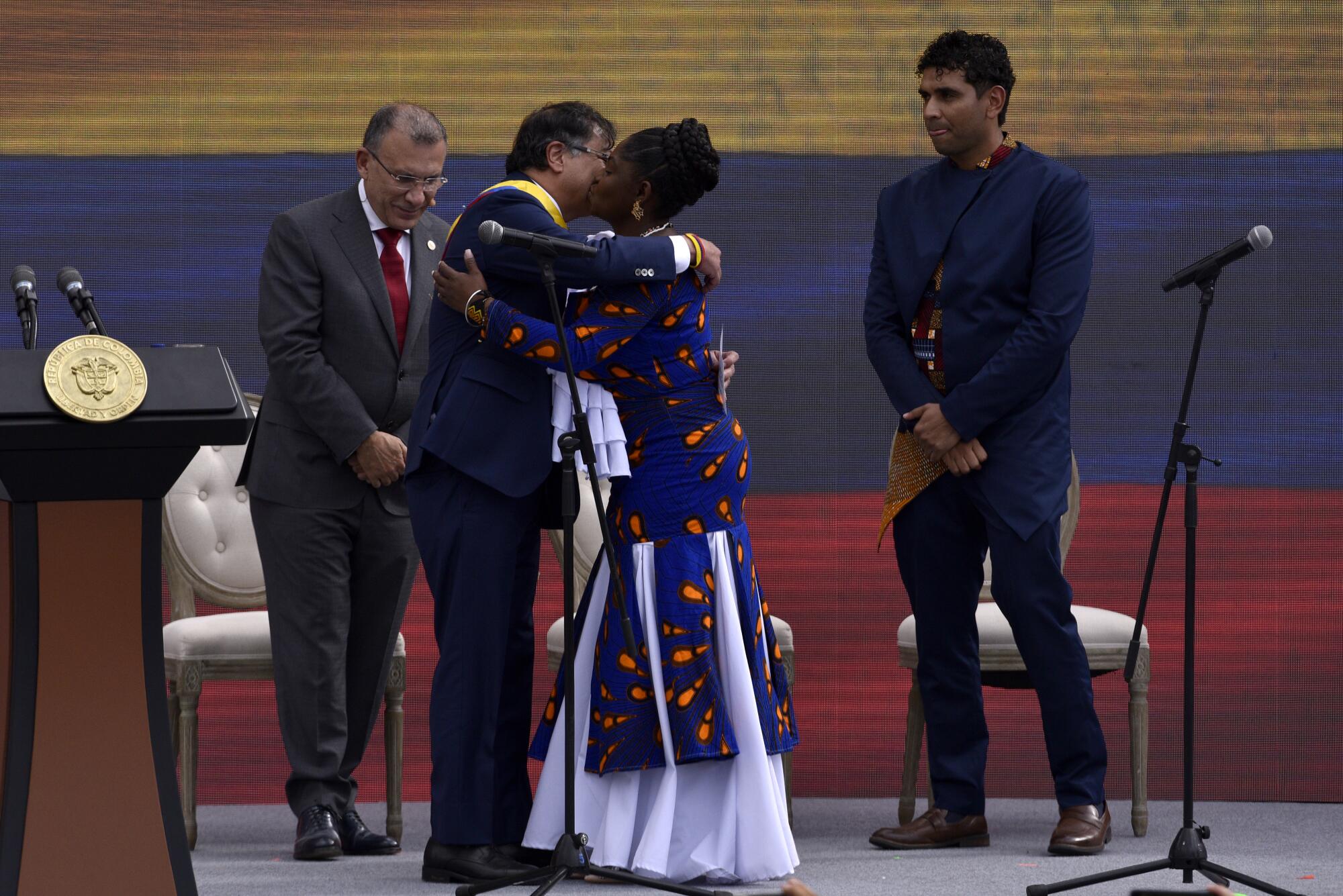
Márquez, who had never before held elective office, is the first person of African heritage to attain such a high post in Colombia, a country where discussion of race has mostly been muted, if not taboo. That is often the case in Latin America, where racism has persisted, typically in a less institutional, albeit no less insidious, manner than in the United States.
Her high-profile advocacy has placed Márquez at the vanguard of an awakening of identity — and push for equality — among the country’s long-marginalized Afro-Colombian masses, who officially tally less than 10% of Colombia’s population. Advocates call that a vast undercount, reflecting centuries of neglect.
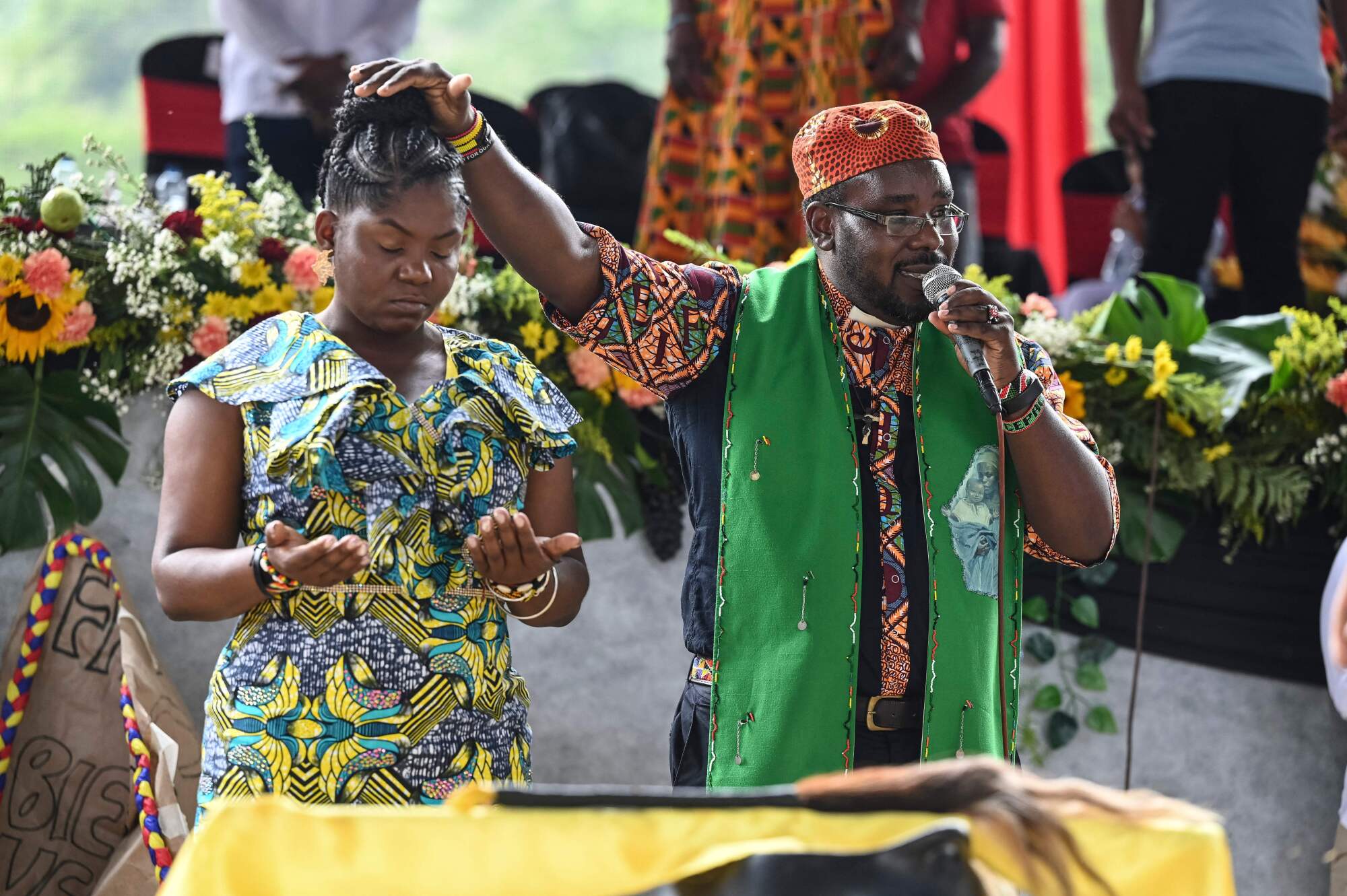
“People of African descent are at the bottom of the pyramid in terms of inequality,” said Helmer Quiñones, an activist who wears a Black Lives Matter pin on his lapel. “Francia Márquez is not the first great political leader in Colombia of African descent. But she also has a global profile, not just domestic.”
Márquez’s big jewelry and multi-patterned outfits have emerged as a style point for admirers from backgrounds rural and urban, poor and wealthy. Her face stares from flamboyant wall murals, many proclaiming her campaign slogan: “Vivir sabroso” — roughly, live life to the fullest.
Afro-Colombians were major participants in nationwide protests last year against what was then a conservative government. The massive street mobilizations, and police violence against protesters, set the stage for a “change” agenda in this year’s national voting.
Still, many didn’t take Márquez’s chances seriously last year when she announced her bid for the presidency. But, in a March primary of the leftist Historic Pact coalition, she garnered almost 800,000 votes.
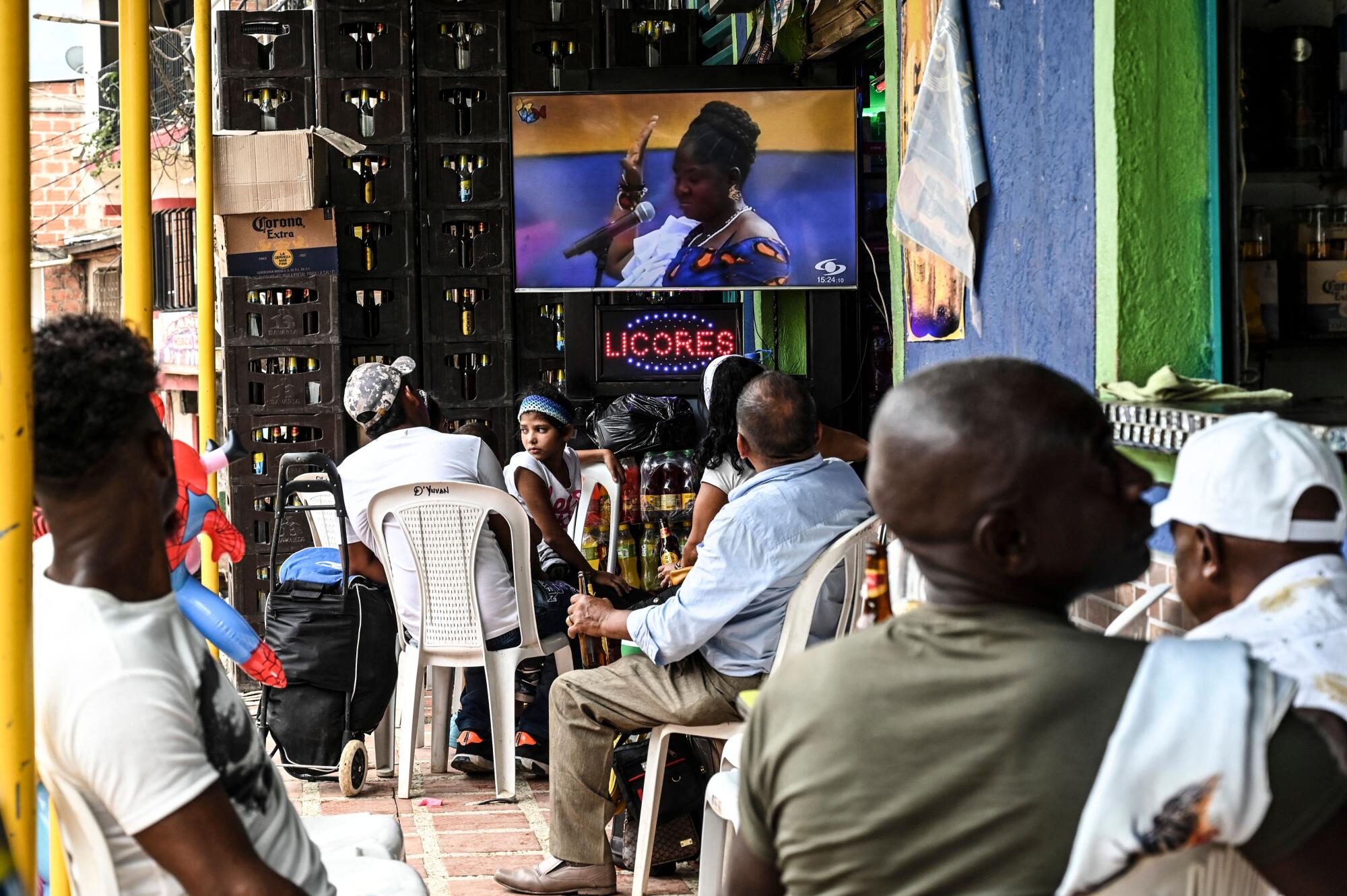
on Aug. 7, 2022.
Petro, a sitting senator and former mayor of Bogota, the capital, won the primary and named Márquez his running mate; in a June runoff, the pair narrowly beat a conservative businessman. Their platform vowed social and political reformation of a nation battered by decades of civil war, narco-violence and deepening inequality.
Márquez calls herself a champion of the “nobodies” — the county’s Black and Indigenous minorities, the poor, working-class women and others at the fringes of a nation historically dominated by a white-mestizo male elite based in the cool Andean climes of Bogota. Most of Colombia’s Afro-descendant peoples hail from the torrid zones along the Pacific and Caribbean coasts.
Beyond race, Márquez has unabashedly challenged sexism, classism, inequality and gender prejudice, among other incendiary topics. She has weathered threats against her life, racist taunts and denied allegations of links to armed guerrillas.
Internationally, Márquez has developed a kind of rock-star following as a fearless crusader for environmental, racial and gender justice, climate change and other timely issues.
“I am part of the struggle against structural racism,” she declared in her 2018 Goldman Prize speech in San Francisco. “Among those women who raise their voices to stop the destruction of rivers, forests and wetlands. Among those who dream that, one day, all human beings are going to change the economic model of death to an economic model of life.”
Her critics label her a divisive figure who deploys multicultural rhetoric to mask a lack of government experience in her ambitious march to the Casa de Narino, the presidential palace.
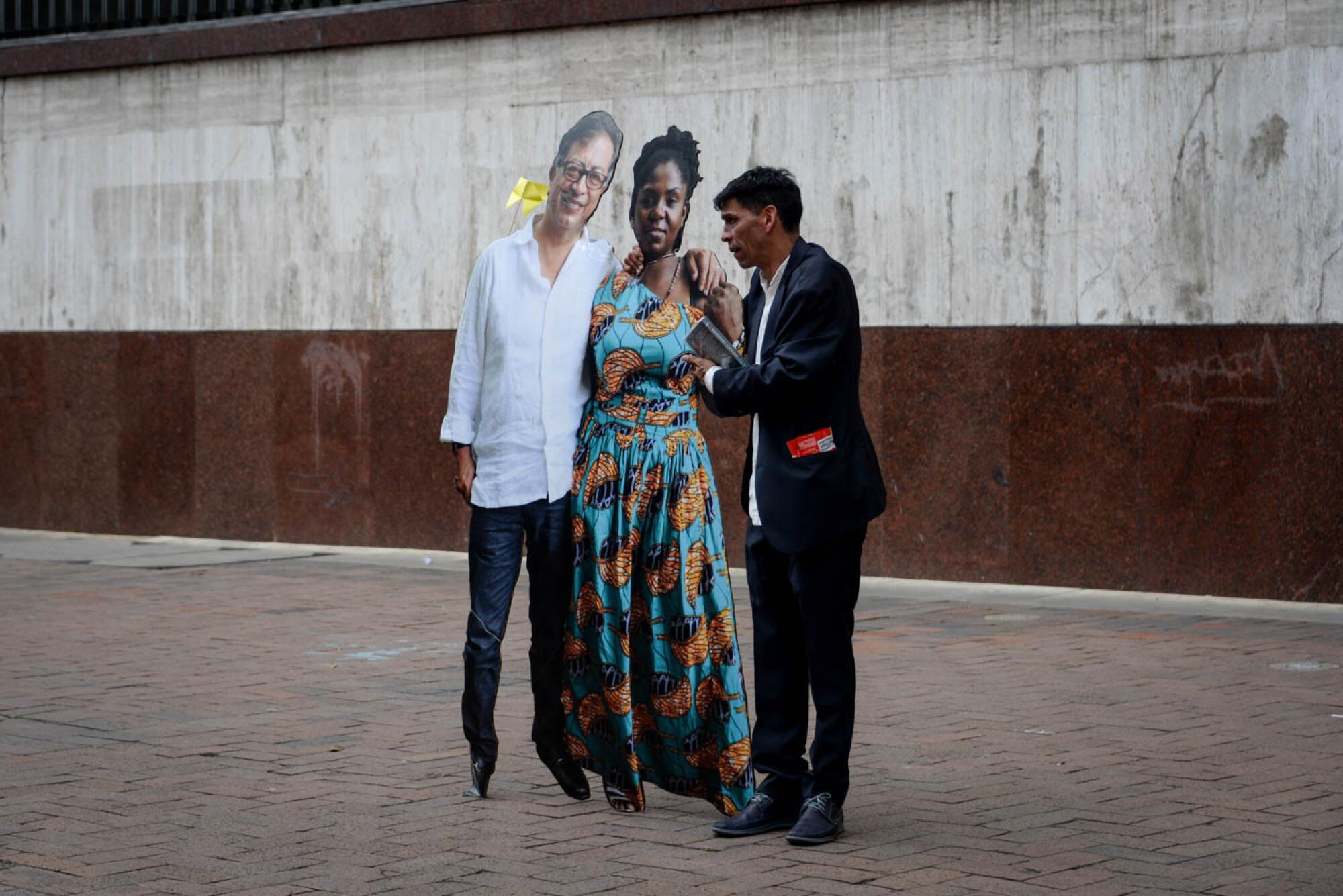
“It’s very convenient for her and her followers to construct a defensive wall that characterizes as racist or classist any type of criticism,” Luis Guillermo Vélez, an opposition politician, wrote during the presidential campaign. “Francia Márquez’s personal story may be admirable.... But that doesn’t exempt her from responding to questions about her political ideas.”
After less than two months in office, Márquez’s exact role in the new administration remains largely undefined, a fact that has unsettled some of her supporters. Márquez has pushed for the creation of a Ministry of Equality, with her at the helm. But that has yet to happen as Petro faces various daunting challenges, notably pacifying a deeply polarized nation.
“The time has come to build peace, a peace that implies social justice,” Márquez said after the election.
Márquez’s activist roots lie here in La Toma, one of a number of predominantly Afro-Colombian townships in Colombia’s southwestern Cauca department.
The region’s breathtaking beauty belies a harsh reality: It is a largely lawless, conflict-ridden zone where narco-traffickers harvest swaths of coca and marijuana, wildcat miners poison waterways and fell forests, and sundry armed groups — guerrillas, killers for hire, paramilitaries, criminal bands — hold sinister sway and grab land.
Colombia perennially ranks among the world’s most perilous places for activists protecting land and water resources. Scores are killed each year. And Cauca is ground zero.
For the people of La Toma and environs, gold mining has historically been a key source of income, supplementing subsistence farming. But gold, and gold fever, have inevitably spurred conflict.
Residents of La Toma have long practiced both alluvial mining — panning in the Ovejas for gold washed down from the hills — and digging for ore in tunnels cut deep into dirt and rock.
In an autobiographical article for Colombia’s El Espectador newspaper, Márquez recalled that Thursdays, Fridays and Saturdays were always dedicated to family gold mining. When she finished primary school, Márquez wrote, her mother — a midwife who had 11 children — said there was no money for further studies. But an aunt invited the young Márquez to work in a mine, a job that provided cash to buy a school uniform, books and cover other educational costs.
“She was very studious, very extroverted and very involved with her process of education,” said Azael Balanta, 54, who was Márquez’s primary school teacher in her home village, Yolombo, one of five villages that make up La Toma, part of the municipality of Suárez. “But I never thought that the Francia Elena who was my student would so quickly become vice president of the Republic of Colombia.”
La Toma, Márquez wrote in El Espectador, has a history of land battles. Her grandfather and other elders were thrown into jail in a dispute with a landlord. Relatives gathered gold to pay a lawyer to help free them.
“The struggle in my territory, in my community ... has passed from generation to generation,” Márquez wrote.
In her youth, she wrote, outsiders would casually fling racist insults — “You are descendants of slaves.” Or: “You come from Africa, a miserable place.”
Early on, Márquez also heard about environmental injustice. The 1980s construction of the Salvajina Dam, on the Cauca River, near La Toma, was widely condemned. The project flooded the lands of thousands of Afro-Colombian and other farmers and devastated traditional fishing, mining and agricultural activities, residents say.
As a teenager, Márquez joined her La Toma neighbors in protesting a multinational company’s plan to divert the Ovejas river — La Toma’s essential water source — to boost power for the Salvajina Dam.
The rising price of gold eventually drew the interest of multinational companies and others keen to cash in on the area’s treasures. Márquez became a plaintiff in a 2010 lawsuit alleging that Colombian authorities had awarded mining rights in La Toma without soliciting community input, as required by law. Colombia’s highest court agreed and suspended the concessions, a major victory — and a signal to Márquez that the legal system could be an ally.
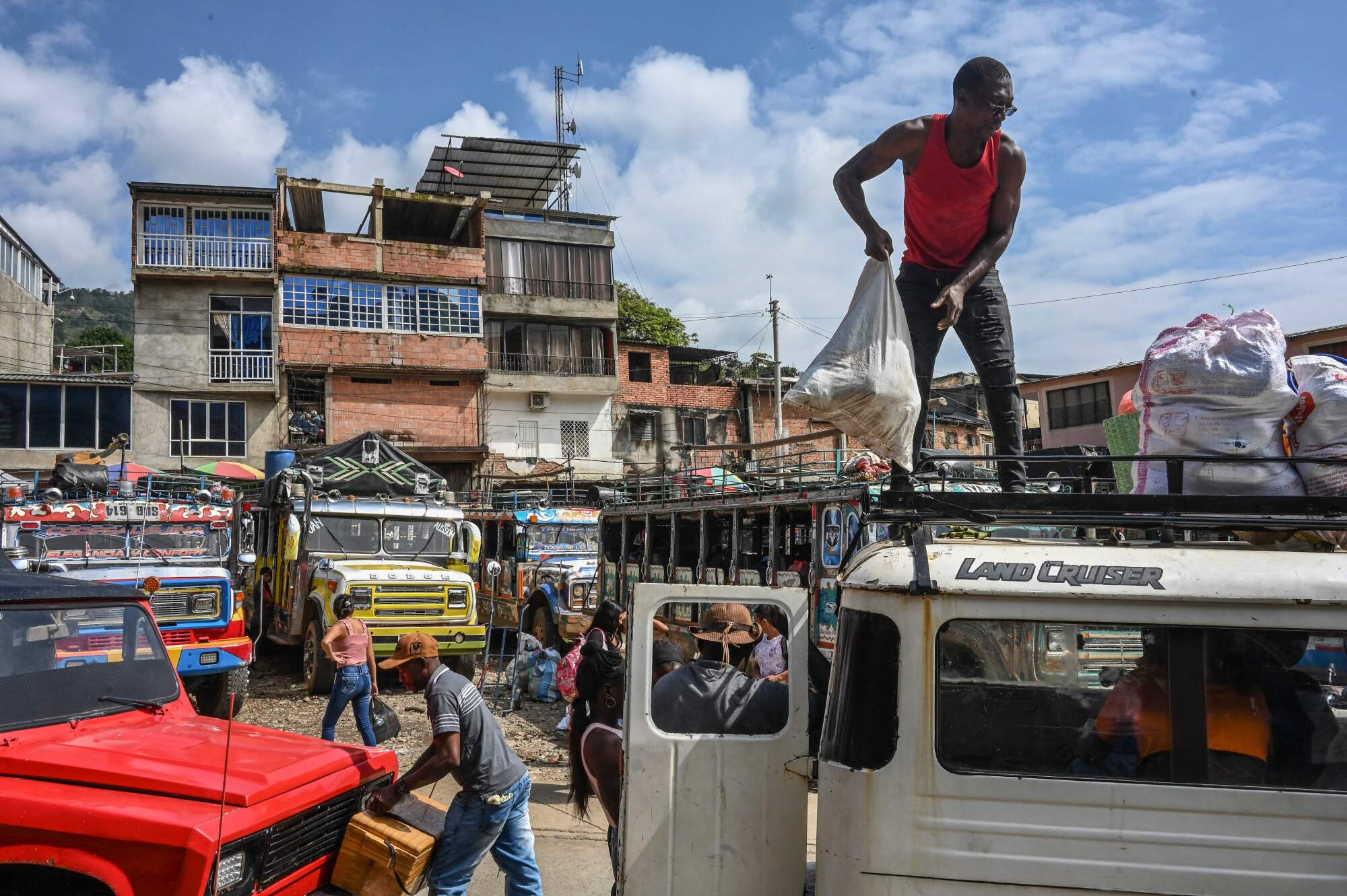
Still, the situation in La Toma and surrounding areas was becoming more fraught. In April 2010, gunmen killed eight miners along the Ovejas. Residents blamed right-wing paramilitary forces in the employ of mining interests. Authorities pointed to leftist guerrillas who impose extortion fees on anyone mining on their turf.
Soon, a rash of bulldozers and backhoes moved into La Toma, tearing up the riverbank and hillsides in search of gold. Gunmen threatened anyone who stood in the miners’ way, residents said. The influx worsened deforestation and increased dumping into the Ovejas of mercury and cyanide, two highly toxic chemicals widely used to separate gold from rock.
The mass intrusion into La Toma provided the impetus for Márquez’s signature act: In November 2014, she burst onto the national stage leading a march of 80 Black women — known as the March of the Turbans, after their African-inspired head attire — from La Toma to Bogota, more than 300 miles away, protesting the presence of the illegal miners.
The demonstrators remained outside the Interior Ministry for three weeks, demanding a solution. Finally, the government relented and agreed to evict the illegal miners.
By then, Márquez was a single mother of two, and had received threats. Joining the ranks of millions of Colombians displaced by violence, she had left vulnerable La Toma for the city of Cali, home to a large Afro-Colombian population, and began studying law.
In 2015, Márquez received a national human rights award. Three years later, she won the Goldman Prize, which thrust her into international prominence.
“She overcame sexism, racism and corruption to lead La Toma’s struggle,” the Goldman citation said. Not long afterward, while working at cleaning houses, Márquez told a newspaper editor: “I’m going to be president one day.”
In La Toma, reached on a bumpy two-hour drive from the nearest major city, Márquez is a figure of adulation. She has also raised some modest expectations — that running water will finally be widely available, that more roads will be paved, that educational opportunities will improve, that the pervasive sense of insecurity will diminish.
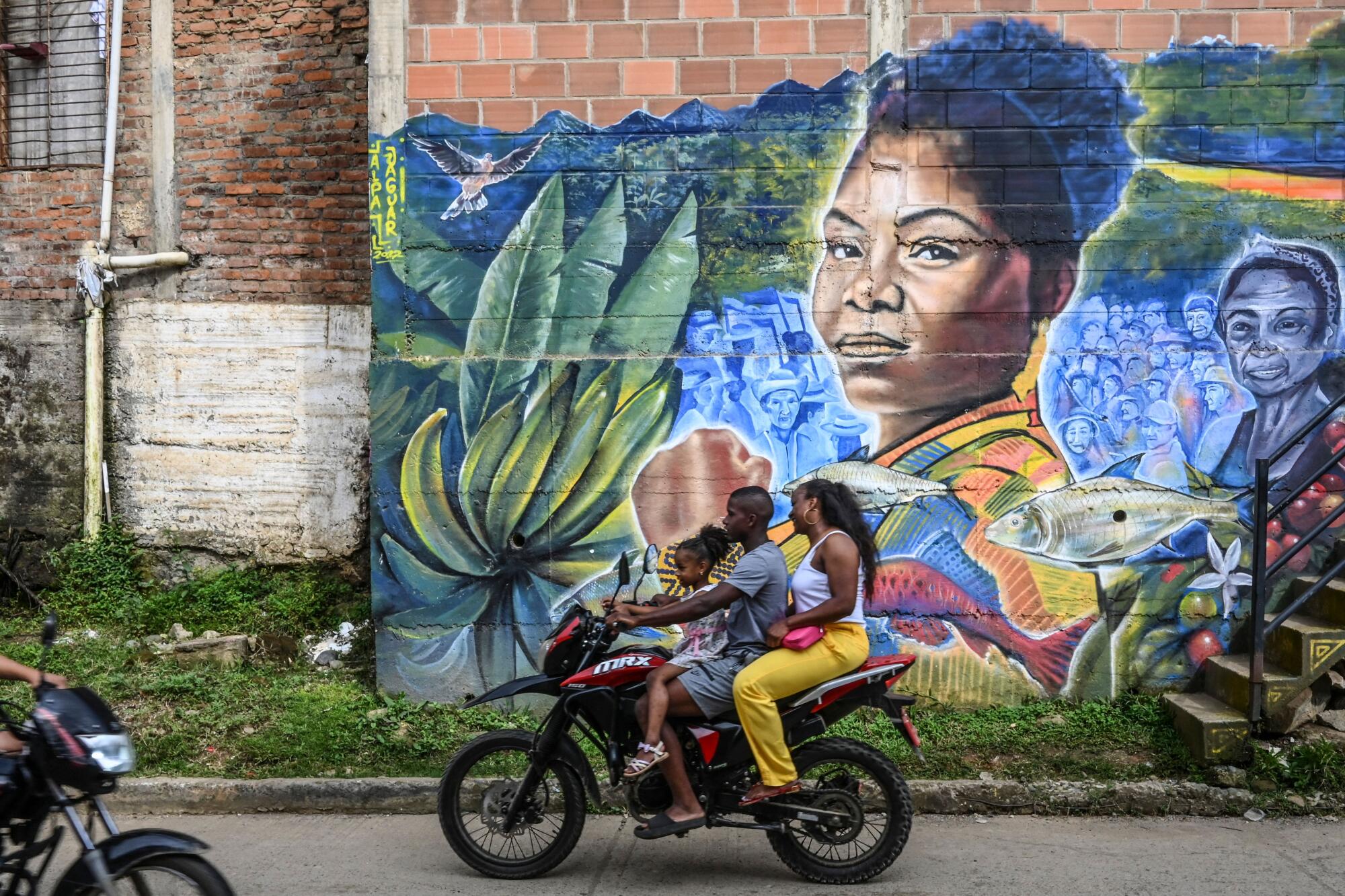
“We want to be able to keep on studying to become better people, just like Francia did,” said Doris Adriana Ocoró, 22, a nursing student who was panning for gold on a recent morning with her husband, as her daughter, 3, watched. “We have learned a lot from Francia, and from our ancestors.”
Over at the Santa Rosa de Lima school, students said Márquez’s ascension had also inspired them. At an outdoor musical performance, Jinller Leany, 12, and Andrea Torres, 15, sang a song about dignity and pride:
I was born Black and my companion is the sun
To the rhythm of the marimba and first the drum
My name is African mixed with Spanish ...
I am proud of my race and I give thanks to God
Proud of my race and I give thanks to God
Black I was born, and Black I am.
Special correspondents Liliana Nieto del Río in La Toma and Cecilia Sánchez in Mexico City contributed to this report.
More to Read
Sign up for Essential California
The most important California stories and recommendations in your inbox every morning.
You may occasionally receive promotional content from the Los Angeles Times.


